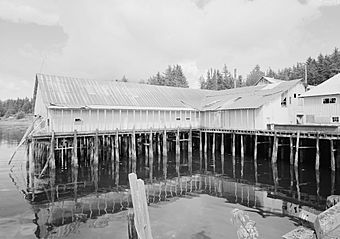Kake Cannery facts for kids
|
Kake Cannery
|
|

Kake Salmon Cannery
|
|
| Location | About 1 mile (1.6 km) southeast of Kake |
|---|---|
| Nearest city | Kake, Alaska |
| Area | 12 acres (4.9 ha) |
| Built | 1912 |
| NRHP reference No. | 97001677 |
Quick facts for kids Significant dates |
|
| Added to NRHP | December 9, 1997 |
| Designated NHLD | December 9, 1997 |
The Kake Cannery is an old fish processing factory located near Kake, Alaska. It was a busy place where fish were prepared and canned from 1912 to 1977. This cannery was one of many in Southeast Alaska, a region famous for its many salmon.
The buildings that are still standing today are some of the best-preserved from that time. They help us understand how people worked in canneries long ago. The Kake Cannery was named a National Historic Landmark in 1997. This means it's a very important historical site.
Contents
What is the Kake Cannery?
The Kake Cannery is about 1 mile (1.6 km) southeast of the small town of Kake, Alaska. Kake is on the northeastern coast of Kupreanof Island. The cannery is also about 90 miles (140 km) south of Juneau.
The cannery complex has 18 buildings that are still standing. Originally, there were about 21 buildings built by the cannery owners. All these buildings are built on wooden poles over the water. Wooden walkways connect them all.
Main Buildings at the Cannery
The main parts of the cannery included four large buildings. These were the main cannery building and three big warehouses.
- Warehouse No. 1 held the company offices. It was also used for storage and had a small shop.
- Warehouse No. 2 was where fishing nets were stored and fixed. Canned fish were also kept here.
- The main cannery building and these two warehouses were built around 1912.
- Warehouse No. 4 was built later, in the 1930s. It had machines that made the metal cans for the fish. (There was no Warehouse No. 3 that we know of).
Living Quarters for Workers
The cannery complex also had different places for the workers to live.
- There were two large bunkhouses. One was for Japanese and Filipino workers. The other was for white workers.
- A third bunkhouse, which was for Chinese workers, is no longer standing.
- Six smaller houses also remain. One was for the supervisor, and another for the cook.
History of the Kake Cannery
The Sanborn Cutting Company built the Kake Cannery in 1912. Over the next few decades, different companies ran it. These included Sunny Point Packing and the Alaska Pacific Salmon Packing Corporation.
In the 1930s, under Alaska Pacific Salmon Packing, the cannery grew. It became one of the biggest fish packing places in the area.
Workers at the Cannery
During this time, different groups of people had different jobs at the cannery. White men often held the jobs with more responsibility. Immigrants from China, Japan, and other places did many of the other tasks. Native Tlingit people were often hired to catch the fish.
Most of these workers were hired through special contractors. These contractors were also in charge of providing housing and food for the workers.
Cannery Changes and Closure
In 1940, P. E. Harris & Company bought the cannery. However, the number of salmon in the area started to go down. Because of this, the cannery closed in 1946.
In 1949, a Native corporation bought the cannery. It reopened as the Keku Cannery. But the reduced number of fish made it hard to operate. Also, the state of Alaska later banned the use of fish traps after it became a state. This made it even harder for the cannery.
The Kake Cannery finally closed for good in 1977.



